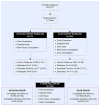Impact of coronary artery calcium scanning on coronary risk factors and downstream testing the EISNER (Early Identification of Subclinical Atherosclerosis by Noninvasive Imaging Research) prospective randomized trial
- PMID: 21439754
- PMCID: PMC3104928
- DOI: 10.1016/j.jacc.2011.01.019
Impact of coronary artery calcium scanning on coronary risk factors and downstream testing the EISNER (Early Identification of Subclinical Atherosclerosis by Noninvasive Imaging Research) prospective randomized trial
Abstract
Objectives: We conducted a prospective randomized trial to compare the clinical impact of conventional risk factor modification to that associated with the addition of coronary artery calcium (CAC) scanning.
Background: Although CAC scanning predicts cardiac events, its impact on subsequent medical management and coronary artery disease risk is not known.
Methods: We assigned 2,137 volunteers to groups that either did undergo CAC scanning or did not undergo CAC scanning before risk factor counseling. The primary end point was 4-year change in coronary artery disease risk factors and Framingham Risk Score. We also compared the groups for differences in downstream medical resource utilization.
Results: Compared with the no-scan group, the scan group showed a net favorable change in systolic blood pressure (p = 0.02), low-density lipoprotein cholesterol (p = 0.04), and waist circumference for those with increased abdominal girth (p = 0.01), and tendency to weight loss among overweight subjects (p = 0.07). While there was a mean rise in Framingham Risk Score (FRS) in the no-scan group, FRS remained static in the scan group (0.7 ± 5.1 vs. 0.002 ± 4.9, p = 0.003). Within the scan group, increasing baseline CAC score was associated with a dose-response improvement in systolic and diastolic blood pressure (p < 0.001), total cholesterol (p < 0.001), low-density lipoprotein cholesterol (p < 0.001), triglycerides (p < 0.001), weight (p < 0.001), and Framingham Risk Score (p = 0.003). Downstream medical testing and costs in the scan group were comparable to those of the no-scan group, balanced by lower and higher resource utilization for subjects with normal CAC scans and CAC scores ≥400, respectively.
Conclusions: Compared with no scanning, randomization to CAC scanning was associated with superior coronary artery disease risk factor control without increasing downstream medical testing. Further study of CAC scanning, including pre-specified treatment recommendations, to assess its impact of cardiovascular outcomes is warranted.
Trial registration: ClinicalTrials.gov NCT00927693.
Copyright © 2011 American College of Cardiology Foundation. Published by Elsevier Inc. All rights reserved.
Figures
Comment in
-
Coronary artery disease. Coronary calcium scanning improves risk factor control.Nat Rev Cardiol. 2011 Jun;8(6):306. doi: 10.1038/nrcardio.2011.69. Epub 2011 Apr 26. Nat Rev Cardiol. 2011. PMID: 21519357 No abstract available.
References
-
- Shaw LS, Raggi P, Schisterman E, Berman DS, Callister TQ. Prognostic value of cardiac risk factors & coronary artery calcium screening for all cause mortality. Radiology. 2003;228:826–833. - PubMed
-
- Kondos GT, Hoff JA, Sevrukov A, et al. Coronary artery calcium and cardiac events electron-beam tomography coronary artery calcium and cardiac events: a 37-month follow-up of 5,635 initially asymptomatic low to intermediate risk adults. Circulation. 2003;107:2571–2576. - PubMed
-
- Arad Y, Goodman KJ, Roth M, et al. Coronary calcification, coronary disease risk factors, C-reactive protein, and atherosclerotic cardiovascular disease events. J Am Coll Cardiol. 2005;46:158–65. - PubMed
-
- Detrano R, Guerci AD, Carr JC, et al. Coronary calcium as a predictor of coronary events in four racial or ethnic groups. N Engl J Med. 2008;358:13336–45. - PubMed
-
- Wilson PWF, D’Agostino RB, Levy D, Belanger AB, Silbershatz H, Kannel WB. Prediction of coronary heart disease using risk factor categories. Circulation. 1998;97:1837–47. - PubMed


